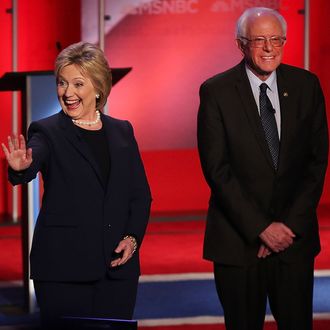
The key takeaway from Sunday night’s Democratic presidential candidates’ debate in Michigan was that Hillary Clinton and Bernie Sanders are managing to find a variety of policy issues on which they differ (or differed in the past), alongside the familiar assertions they continue to make about their basic differences in ideological orientation. With Tuesday’s Michigan primary voters in mind, Sanders hit Clinton on her past support for multilateral trade agreements, while Clinton hit Sanders on his vote against the 2009 auto-industry bailout.
Michigan may provide us with our best test yet as to whether issue differences between these two candidates matter — or instead, as proved to be the case in the last contested Democratic presidential nominating contest, whether candidate preferences are mostly about who you are rather than what, specifically, you think.
In 2008, in state after state, the Obama-versus-Clinton battle turned on demography rather than policy, with Obama’s coalition of African-Americans, younger voters, and independents matched against Clinton’s coalition of Latinos, older (and especially older female) voters, and blue-collar white Appalachians.
So far demography has been the primary determinant of candidate preference this year as well, with Clinton sweeping every state with a significant African-American voting population (with the arguable exception of Oklahoma), while Sanders wins states dominated by white liberals. This year’s massive division of Democratic voters by age is coming close to exceeding the divisions between black and white voters in 2008 — more than can be explained by any ideological or policy-oriented differences between candidates or voters.
This pattern is more than a bit surprising. For one thing, the ideological contrasts in this year’s two campaigns, with Clinton hewing close to Barack Obama’s legacy and Sanders promising a “political revolution” and implicitly criticizing both the Clinton and Obama administrations, are much clearer than those of 2008, when the most prominent issue difference (other than their past positions on the Iraq War) involved a wonky health-care-policy argument over the need for an individual insurance mandate (ironically, of course, Obama adopted Clinton’s position once in office). For another thing, Obama and Clinton to a considerable extent personified the demographic splits among Democrats. This time around Clinton’s most intense demographic support group does not share her race, and Sanders is several generations older than the under-30 voters who so powerfully feel the Bern. So you’d figure that in theory either or both campaigns could get out of their current demographic ruts.
Michigan may well tell us if that’s the case. Clinton’s demographic ace in the hole is the roughly one-fourth of likely primary voters who are African-American, where polls show her winning over 70 percent. In contrast to the southern states where she romped to victory on Super Tuesday (and again over the weekend in Louisiana), black voters are not quite enough to guarantee victory in Michigan. So she’s counting on older white (and especially women) voters and those swayed by her support for the auto bailout (the United Auto Workers, like the AFL-CIO, is remaining neutral in the primary). Meanwhile, Sanders is hoping his longtime pro-labor voting record and especially his systematic opposition to every trade agreement dating back to and beyond NAFTA will break the mold for him in Michigan.
Let’s hope the exit polling from Michigan is well conducted. It may tell us a lot about the rest of the Democratic nominating contest, and particularly whether what has looked to be a demographically doomed Sanders campaign can make a real fight of it.






























